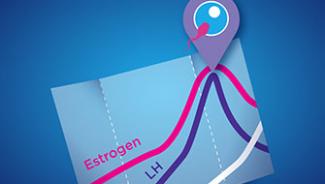Home pregnancy tests: Your most pressing questions, answered

Taking a home pregnancy test is easy, right? Well, yes and no. When using a stick pregnancy test, the process is quick, simple and accurate, and the included instruction booklet will tell you everything you need to know. But emotions can be high in the moment, and invariably, questions arise. Here’s what you should know.
In this article
- How long should I wait before taking a home pregnancy test?
- Should I dip my home pregnancy test in urine, or pee on it?
- What factors can affect the accuracy of a pregnancy test?
- How often are tests wrong? Are they ever wrong?
- What does a faint positive line mean?
- What if I take multiple tests and the results are different each time?
- Are blood tests more accurate?
How long should I wait before taking a home pregnancy test?
![]() If you use an early detection pregnancy test, detectible amounts of hCG (human chorionic gonadotropin) can be found in your urine a few days sooner than your missed period — depending on the product, this could be up to six days before your missed period or five days before your expected period. Word choice is important here, so let’s break this down a bit more. If you expect your period to arrive on the 10th day of the month, the 10th is the day of your expected period and the 11th is the day of your missed period. Therefore, with a “six day early test,” for instance, you could test on the 5th, which is five days before your expected period and six days before your missed period.
If you use an early detection pregnancy test, detectible amounts of hCG (human chorionic gonadotropin) can be found in your urine a few days sooner than your missed period — depending on the product, this could be up to six days before your missed period or five days before your expected period. Word choice is important here, so let’s break this down a bit more. If you expect your period to arrive on the 10th day of the month, the 10th is the day of your expected period and the 11th is the day of your missed period. Therefore, with a “six day early test,” for instance, you could test on the 5th, which is five days before your expected period and six days before your missed period.
Your body doesn’t begin producing hCG until a fertilised egg implants in your uterine wall. For about the first 10 days after conception, the amount of hCG is undetectable. According to Human Chorionic Gonadotropin1, during the first eight weeks of pregnancy, hCG doubles about every 24 hours. Read the test’s instruction booklet to determine what day you can start testing. Our online calculator also can help.
Should I dip my home pregnancy test in urine, or pee on it?
![]() Most tests allow you to either place the absorbent tip in your urine stream for (usually) five seconds or dip the tip in a collected urine sample for five to twenty seconds. Accuracy is not dependent on the method as long as you follow the instructions.
Most tests allow you to either place the absorbent tip in your urine stream for (usually) five seconds or dip the tip in a collected urine sample for five to twenty seconds. Accuracy is not dependent on the method as long as you follow the instructions.
Keep in mind: If you choose to pee on the stick, place just the absorbent tip in your urine stream. Do not allow the urine level to go above the plastic housing of the test stick. Also, make sure to keep the test stick in your urine stream for only the designated time. Five seconds feels a bit longer when aiming your pee, but pulling the stick away too quickly or not leaving it in your urine stream long enough can affect the validity of the result.
If you choose to dip, use a clean, dry container stable enough to hold the test and urine without tipping. Read the instructions to determine exactly how long the tip should remain in the urine. If you’re not using a digital test, consider using a timer — three minutes can feel like an eternity when waiting for results, and to ensure an accurate result, it’s important to keep the test in the urine for the correct amount of time. If your container spills and your test falls on the floor (this happens), consider retesting2.
No matter how you test, when using a test stick always point the absorbent tip downward. When you’re finished, if your test has a cap put it back on the tip and lay the test on a flat surface facing upwards.
What factors can affect the accuracy of a pregnancy test?
![]() The amount of hCG at any point in pregnancy varies from woman to woman. So while one pregnant woman may see a positive result four or five days before her expected period, another woman may not have enough detectable hCG until three days before her expected period. For reference, if using the Clearblue® Ultra Early Pregnancy Test, 79% of pregnancies can be detected six days before a missed period. If you wait until the day of your expected period, pregnancy detection shoots to 99%, assuming you’ve calculated your period correctly.
The amount of hCG at any point in pregnancy varies from woman to woman. So while one pregnant woman may see a positive result four or five days before her expected period, another woman may not have enough detectable hCG until three days before her expected period. For reference, if using the Clearblue® Ultra Early Pregnancy Test, 79% of pregnancies can be detected six days before a missed period. If you wait until the day of your expected period, pregnancy detection shoots to 99%, assuming you’ve calculated your period correctly.
If you haven’t missed your period yet, hCG will be most concentrated in your urine first thing in the morning. Limit your liquid intake prior to testing to avoid dilution.
Make sure to store pregnancy tests between 2° and 30° C. Also, tests do expire, so check the expiration date before using.
How often are tests wrong? Are they ever wrong?
![]() A false positive is rare. If you’ve missed your period, 99% of the time a positive result is accurate. False positives can occur if you’re taking fertility medications that contain hCG, if you have a rare medical condition (such as an ovarian cyst) or if you’ve recently had a birth, miscarriage or termination. Some women may get a positive result and then experience early pregnancy loss3.This is a real pregnancy that did not continue — it’s not a false positive.
A false positive is rare. If you’ve missed your period, 99% of the time a positive result is accurate. False positives can occur if you’re taking fertility medications that contain hCG, if you have a rare medical condition (such as an ovarian cyst) or if you’ve recently had a birth, miscarriage or termination. Some women may get a positive result and then experience early pregnancy loss3.This is a real pregnancy that did not continue — it’s not a false positive.
A negative test doesn’t necessarily mean you’re not pregnant. If testing early, you may have undetectable hCG levels. You also may have calculated the date of your expected period incorrectly. Using an expired test or not storing it properly (see above) can result in a false negative.
If you think you’re pregnant and the test is negative but you haven’t hit your expected period date, test again on the day you expect your period. If you think you’re pregnant, the test is negative and you’ve missed your period, test again three days later. If the test is still negative but you still think you’re pregnant, talk to your doctor.
What does a faint positive line mean?
![]() A faint line can cause confusion. While digital pregnancy tests provide clear words — “Pregnant” or “Not Pregnant” — Clearblue visual tests use lines to display the results. If you see a positive line (no matter how faint!) in addition to the control line, you’re pregnant.
A faint line can cause confusion. While digital pregnancy tests provide clear words — “Pregnant” or “Not Pregnant” — Clearblue visual tests use lines to display the results. If you see a positive line (no matter how faint!) in addition to the control line, you’re pregnant.
For Clearblue tests, faint result lines occur if your hCG levels aren’t very high, if you tested early or didn’t test first thing in the morning, if you drank too much liquid or if you didn’t follow the instructions. Check out examples of faint lines here.
What if I take multiple tests and the results are different each time?
![]() Rarely will a negative test follow a positive test. If a negative test follows, it could mean that you are no longer pregnant. This can be heartbreaking. Know that repeated early pregnancy loss isn’t common and most women go on to have successful pregnancies.
Rarely will a negative test follow a positive test. If a negative test follows, it could mean that you are no longer pregnant. This can be heartbreaking. Know that repeated early pregnancy loss isn’t common and most women go on to have successful pregnancies.
Sometimes a positive test will follow a negative test. This could be due to the timing of the negative test and a subsequent rise in your hCG levels.
Are blood tests more accurate?
![]() Both blood and urine tests work by detecting the level of hCG in your body, and both are similar in accuracy4. A blood test taken before a missed period is equal in accuracy to an early detection pregnancy test. Thankfully, in most countries gone are the days of visiting your doctor for a blood test and waiting for the phone to ring with results.
Both blood and urine tests work by detecting the level of hCG in your body, and both are similar in accuracy4. A blood test taken before a missed period is equal in accuracy to an early detection pregnancy test. Thankfully, in most countries gone are the days of visiting your doctor for a blood test and waiting for the phone to ring with results.
Sources :
- Betz, D., & Fane, K. (2021). Human Chorionic Gonadotropin [E-book]. StatPearls. https://www.ncbi.nlm.nih.gov/books/NBK532950/
- “Knowing if you are pregnant,” (2019, January 30). Office on Women’s Health, U.S. Department of Health & Human Services. https://www.womenshealth.gov/pregnancy/you-get-pregnant/knowing-if-you-are-pregnant
- “Early Pregnancy Loss.,” (2015, August). The American College of Obstetricians and Gynecologists. https://www.acog.org/womens-health/faqs/early-pregnancy-loss
- “Pregnancy Test,” (n.d.), U.S. National Library of Medicine, retrieved April 29, 2021, from https://medlineplus.gov/lab-tests/pregnancy-test/

How to get pregnant faster
There are a few key things you need to know if you want to maximise your chances of getting pregnant.

How to use a pregnancy test
When and how you can test depends on the test you use, but in this article you will find everything you need to know before starting a test.




